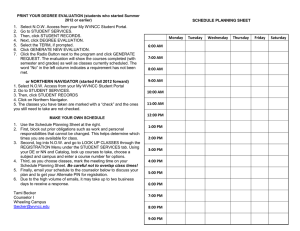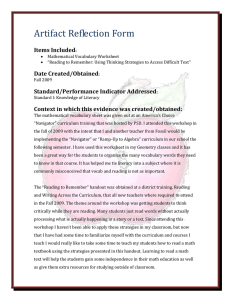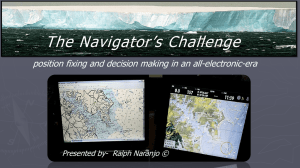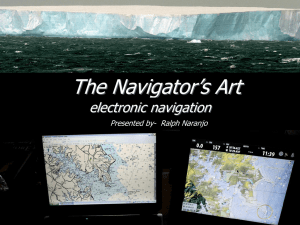GEOVISUALIZATION OF PLANNED AND EXECUTED ROUTES FOR LAND
advertisement
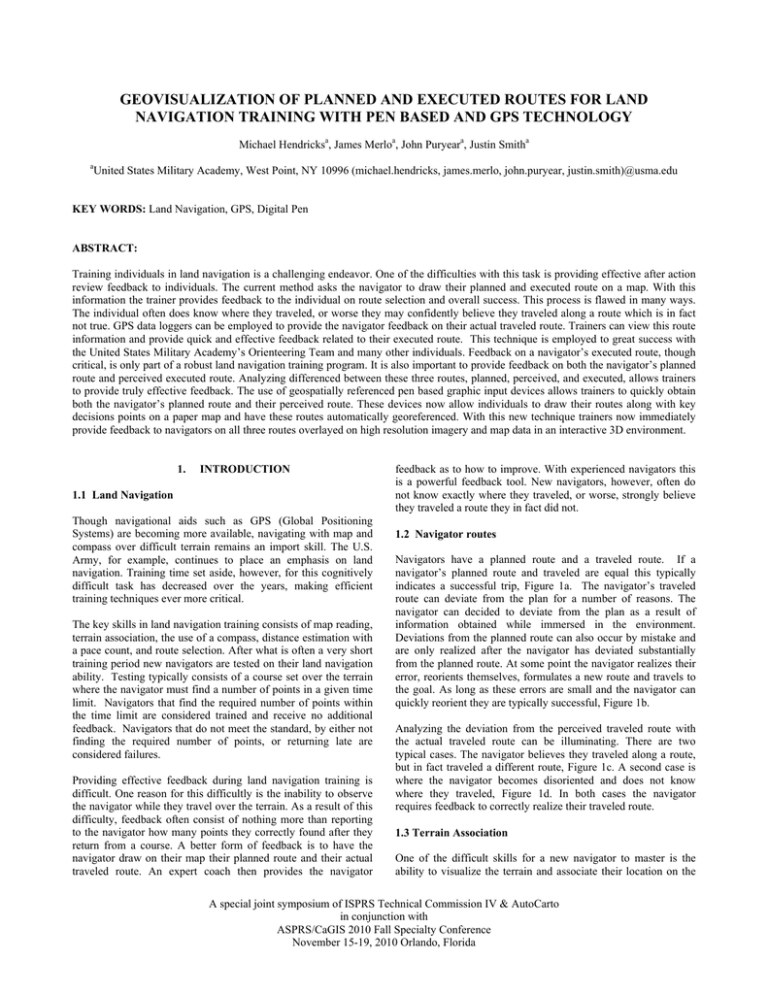
GEOVISUALIZATION OF PLANNED AND EXECUTED ROUTES FOR LAND NAVIGATION TRAINING WITH PEN BASED AND GPS TECHNOLOGY Michael Hendricksa, James Merloa, John Puryeara, Justin Smitha a United States Military Academy, West Point, NY 10996 (michael.hendricks, james.merlo, john.puryear, justin.smith)@usma.edu KEY WORDS: Land Navigation, GPS, Digital Pen ABSTRACT: Training individuals in land navigation is a challenging endeavor. One of the difficulties with this task is providing effective after action review feedback to individuals. The current method asks the navigator to draw their planned and executed route on a map. With this information the trainer provides feedback to the individual on route selection and overall success. This process is flawed in many ways. The individual often does know where they traveled, or worse they may confidently believe they traveled along a route which is in fact not true. GPS data loggers can be employed to provide the navigator feedback on their actual traveled route. Trainers can view this route information and provide quick and effective feedback related to their executed route. This technique is employed to great success with the United States Military Academy’s Orienteering Team and many other individuals. Feedback on a navigator’s executed route, though critical, is only part of a robust land navigation training program. It is also important to provide feedback on both the navigator’s planned route and perceived executed route. Analyzing differenced between these three routes, planned, perceived, and executed, allows trainers to provide truly effective feedback. The use of geospatially referenced pen based graphic input devices allows trainers to quickly obtain both the navigator’s planned route and their perceived route. These devices now allow individuals to draw their routes along with key decisions points on a paper map and have these routes automatically georeferenced. With this new technique trainers now immediately provide feedback to navigators on all three routes overlayed on high resolution imagery and map data in an interactive 3D environment. 1. INTRODUCTION 1.1 Land Navigation Though navigational aids such as GPS (Global Positioning Systems) are becoming more available, navigating with map and compass over difficult terrain remains an import skill. The U.S. Army, for example, continues to place an emphasis on land navigation. Training time set aside, however, for this cognitively difficult task has decreased over the years, making efficient training techniques ever more critical. The key skills in land navigation training consists of map reading, terrain association, the use of a compass, distance estimation with a pace count, and route selection. After what is often a very short training period new navigators are tested on their land navigation ability. Testing typically consists of a course set over the terrain where the navigator must find a number of points in a given time limit. Navigators that find the required number of points within the time limit are considered trained and receive no additional feedback. Navigators that do not meet the standard, by either not finding the required number of points, or returning late are considered failures. Providing effective feedback during land navigation training is difficult. One reason for this difficultly is the inability to observe the navigator while they travel over the terrain. As a result of this difficulty, feedback often consist of nothing more than reporting to the navigator how many points they correctly found after they return from a course. A better form of feedback is to have the navigator draw on their map their planned route and their actual traveled route. An expert coach then provides the navigator feedback as to how to improve. With experienced navigators this is a powerful feedback tool. New navigators, however, often do not know exactly where they traveled, or worse, strongly believe they traveled a route they in fact did not. 1.2 Navigator routes Navigators have a planned route and a traveled route. If a navigator’s planned route and traveled are equal this typically indicates a successful trip, Figure 1a. The navigator’s traveled route can deviate from the plan for a number of reasons. The navigator can decided to deviate from the plan as a result of information obtained while immersed in the environment. Deviations from the planned route can also occur by mistake and are only realized after the navigator has deviated substantially from the planned route. At some point the navigator realizes their error, reorients themselves, formulates a new route and travels to the goal. As long as these errors are small and the navigator can quickly reorient they are typically successful, Figure 1b. Analyzing the deviation from the perceived traveled route with the actual traveled route can be illuminating. There are two typical cases. The navigator believes they traveled along a route, but in fact traveled a different route, Figure 1c. A second case is where the navigator becomes disoriented and does not know where they traveled, Figure 1d. In both cases the navigator requires feedback to correctly realize their traveled route. 1.3 Terrain Association One of the difficult skills for a new navigator to master is the ability to visualize the terrain and associate their location on the A special joint symposium of ISPRS Technical Commission IV & AutoCarto in conjunction with ASPRS/CaGIS 2010 Fall Specialty Conference November 15-19, 2010 Orlando, Florida ground with their location on the map. Land Navigators typically employ topographic maps to plan routes and help visualize the terrain while traveling. An important aspect of the terrain is elevation and how it changes to create earth forms such as hills, valleys, spurs, draws, and saddles. To represent these 3-D forms on a 2-D topographic map, contour lines are employed. finish finish Hill 105 Hill 105 start start (a) SUCCESS Planned Route equals both Perceived and Actually Traveled Routes (b) PARTIAL SUCCESS Traveled Route deviated from Planned Route. Perceived and Actually Traveled Routes are equal, navigator understands deviation finish finish ? Hill 105 Hill 105 start start (c) (d) NEAR FAILURE FAILURE Traveled Route deviated from Traveled Route deviated from Planned Route. Perceived Planned Route. Traveled Route Traveled Route also deviates unknown, navigator lost from Actual Traveled, navigator misunderstands deviation Planned Navigator Routes Perceived Actual Figure 1. Navigator Routes Contours indicate lines of equal elevation. Many navigators have difficulty converting the 2-D representation of a contour line into a 3-D mental model of the terrain. Providing feedback to new navigators on this skill is easier said than done. One effective method is to have an expert coach conduct terrain walks with new navigators, where they travel to terrain features and reference these feature on the topographic map. Technology now provides an additional feedback tool, with the advent of terrain visualization software, such as Google Earth. Navigators can now quickly and with little effort explore the terrain and increase their understanding of earth forms. 1.4 Map Scale The terrain on which navigators travel is highly complex. Topographic maps simplify this complexity with standard symbols on the map’s 2-D surface. The map scale has a significant impact on the level of detail available to the navigator. The standard scales for navigation over the years have been 1:50,000 and in some cases 1:25,000 or 1:24,000. Navigators often have difficulty relating the highly generalized earth surface forms on these maps to the actual earth surface they are traveling over, with its many unmapped features such as small knolls, hills, vegetation and intermittent streams. Large scale maps with an increased level of detail can be of assistance. For example, the 1:10,000 scale maps used by the sport of orienteering provide a much close representation of the actual earth surface. These maps are time consuming and expensive to produce and are not available in most areas. 1.5 Navigator’s Traveling Characteristics – Speed, Distance, and Direction The navigator’s speed while traveling through the environment provides clues as to their state of mind. Traveling at a constant and high speed typically indicates confidence. Erratic speeds are indicative of navigator uncertainty. When navigators stop moving for extended periods of time this typically indicates a state of significant uncertainty. Navigators determine distance while traveling through the terrain with a technique known as pace counting. A navigator must know the number of paces he or she takes in a given distance, typically 100 meters. The pace count changes based on slope, vegetation, and even the navigator’s state of mind. For example, we typically find that new navigators fall short on their pace count when traveling up steep slopes. A navigator can determine the direction of travel with a compass or based on the terrain, through terrain association. The importance of reliance on a compass for direction is terrain dependent. In terrain without identifiable mapped features the compass becomes the primary source of direction information. In areas where there are many identifiable features on the map, terrain association can be sufficient. New navigators, however, are often not skilled at terrain association and rely more on compass directions. Feedback on direction can be simply related to determining if a navigator reads their compass correctly and travels in the proper direction. Another error that occurs is that the navigator does not travel in a constant direction and deviates from the direction indicated on their compass. A special joint symposium of ISPRS Technical Commission IV & AutoCarto in conjunction with ASPRS/CaGIS 2010 Fall Specialty Conference November 15-19, 2010 Orlando, Florida Since navigators typically do not travel on a featureless plain it is useful to use the terrain to their advantage. Providing feedback on the direction they travel in regards to the terrain is helpful. For example, did the navigator travel straight over a hill, blindly following their compass, or did they use natural draws and spurs to their advantage. Current methods of providing feedback to navigators on their planned and traveled routes, along with feedback on speed, distance and direction is lacking. As a result we developed an improved land navigation After Action Review (AAR) system that employs a number of innovative technologies to provide an increased level of feedback detail to the navigator. testing we found the horizontal positional accuracy to be comparable, if not better, than the Garmin 305 GPS units. To download the GPS tracks we employed QStarz provided software, Travel Recorder PC Utility Version 5. We set the GPS to collect once every second. Though this uses more memory and in many applications is not required, this level of data is critical to determine navigator speeds. By having data every second you can get a better understanding of when the navigator is slowing down or stopping. This can be very helpful during the After Action Review with the expert coach. The major challenge with this device, and we expect any GPS system, is charging the large number of units after each training event. 2.3 Digital Ink Pens 2. LAND NAVIGATION AAR SYSTEM 2.2 System Requirements The Land Navigation AAR system is designed to provide timely and effective feedback to navigators. The system requirements were as follows • • • • • The system must not provide assistance to the navigator while traveling, since the skill being developed is land navigation with map and compass. The system must not require equipment that encumbers the navigator. The system must not be a time or effort burden to the trainers and must accommodate up to a ninety cadets a day. The system must provide feedback on planned, perceived traveled routes and actually traveled routes. The system must provide information on the speed, distance, and direction of travel. To achieve these requirements we developed a system that employed both GPS and Digital Pen based technology to provide feedback on routes and travel characteristics to the navigator immediately after their course. 2.2 GPS To obtain the navigator’s actual traveled route, along with speed, distance, and direction feedback, we used GPS. Since we were focused on after action review feedback, there was no emphasis on real time tracking. There are many GPS units to choose from. The authors had experience with Garmin’s 305 wrist worn sports watches used by the Academy’s Orienteering Team. Through experience, these devices typically provide at least 15 meter horizontal positional accuracy in the forest. This accuracy is adequate, in most cases, to determine routes even on 1:10,000 orienteering maps. These units however, provide a display to the navigator, with information such as speed, direction, and distance which was not allowed. In addition we did not have the funding to purchase a large number of these devices. As such we chose instead to purchase QStarz BT-Q1300S GPS Data loggers. They provided a cheap light weight solution that provides no immediate display to the navigator. Through earlier To gather information on the navigators planned and perceived traveled routes we had a number of options. The first option was the least desirable and would consist of merely asking the navigator to verbally explain their two routes during the AAR. The second option is to have the navigator draw their routes on a paper map with a pencil. Though simple and easy to accomplish, relating these routes to the GPS track of their actually traveled route displayed on a computer screen is difficult. A third option is to have the navigators digitally draw their routes directly on a computer. It was determined that we would not have enough computers to support this process and at the same time provide After Action Reviews. The forth option, which we choose to implement, employs the relatively new technology of “digital ink”, and allows navigators to use pen and paper to draw their routes and then quickly import this data into the computer and have these routes aligned properly with the GPS tracks. We chose to utilize technology from ADAPX. ADAPX’s technology works through printing forms, maps, or other documents with “pattern” that allows its specialized pen to read the location of pen strokes on the printed page. After a user or many users draw on the page or pages the pen is docked and the data uploaded into the form, map or document. This process allows, in our case, maps to be printed for navigators to draw their routes on without taking up valuable computer space. In addition, it was believed that the act of drawing on a paper map with a pen would be easier for navigators. To draw routes on maps we had two options from ADAPX. The first option was to use their ArcGIS extension. With this technology we could design a map with a legend indicating the features we wanted navigators to add to the map. A navigator would “select” a feature to draw from the printed map’s legend by touching it with the pen. When they draw on the map, the pen knows what layer these strokes should be added to when the pen is docked. For example, if a navigator wants to add a Planned Route to the map they touch the Planned Route symbol in the legend, then draw the route on the map. When the pen is docked the route is added to the Planned Route shapefile or feature class in ArcGIS. Even though a user is selecting various layers to add, it must be noted that the actual pen strokes on the printed page are all one color, black. Because of licensing constraints while disconnected from our network, and concerns about the speed of processing it was decided to employ a second option. A special joint symposium of ISPRS Technical Commission IV & AutoCarto in conjunction with ASPRS/CaGIS 2010 Fall Specialty Conference November 15-19, 2010 Orlando, Florida We chose instead a second option that used ADAPX for Acrobat prototype software (now in production) that allows pen data to be imported into Adobe Acrobat files. Pen strokes are added to the Acrobat files and can then be viewed or exported. There is no notion of data layers, as with the ArcGIS extension, and all strokes are considered equal. There is a mechanism to change the color of the digital ink, which we had difficulty implementing with the prototype software. 2.5 Visualizing in 3D - Google Earth We printed a specific AAR map for each navigator with an identification number to correspond to the GPS that they would be issued, Figure 2. The pen “knows” what map was drawn on and when docked with the computer, the digital ink is added to the correct Acrobat file. We determined that as a minimum our system must have available in Google Earth the points that the navigators would be finding, along with the maps that they would be using. In our case the navigators would employ both a 1:25,000 and a 1:50,000 topographic map. In addition, it was desirable to include supplementary reference maps, specifically we wanted to include a 1:10,000 orienteering map to provided more detailed terrain information during the AAR. To be useful for feedback in a navigation based system, however, we must also include addition software that provides positional awareness into Acrobat files along with Keyhole Markup Language (.kml) export capability. TerraGo’s Composer for Acrobat and TerraGo’s Publisher for ArcGIS provide this functionality. To provide a 3D visualization of the terrain to navigators during the After Action Review we decided to use Google Earth. Google Earth provides a simple and comfortable interface for both the navigator and expert coach conducting the AAR. The default imagery, though marginally useful was not adequate for an effective AAR. Google Earth has a raster size limitation that does not allow high resolution imagery to be added directly. As a result, we created a pyramid of tiled raster datasets for each map layer. We created and/or adjusted the desired maps in ArcGIS 9.3.1 and then used a piece of software named SuperOverlay to create tiled raster dataset pyramids, consisting of small JPG images all referenced by one .kml file for use in Google Earth. Planned routes and percieved traveled routes along with GPS tracks of actually traveled routes stored as .kml files can be easily imported and overlaid on the maps described above. A new feature of Google Earth that appeared recently is a more direct support of GPS data in .gpx form and the inclusion of elevation profiles, Figure 3 and 4. The primary limitation of Google Earth was the relatively course elevation data that it provides and the difficulty in adding higher resolution data. Figure 2: GeoPDF of 1:50,000 topographic map printed at 1:25,000 for navigators to draw planned route and perceived traveled route. 2.4 GeoPDF A GeoPDF file acts as a traditional Adobe Acrobat file, but includes geographic coordinates. Using TerraGo’s Publisher for ArcGIS extension we created GeoPDFs of both the 1:25,000 and 1:50,000 topographic maps. This GeoPDF file was then printed with ADAPX pattern and used by the navigator to draw planned routes and perceived traveled routes. When the pen is docked these routes are added to the navigator’s GeoPDF. These routes, and all strokes made by the pen, can then be exported with TerraGo’s toolbar into .kml files to be viewed in Google Earth. Figure 3: Example Google Earth screen shot with the three navigator routes displayed on the 1:25,000 topographic map. A special joint symposium of ISPRS Technical Commission IV & AutoCarto in conjunction with ASPRS/CaGIS 2010 Fall Specialty Conference November 15-19, 2010 Orlando, Florida Process Station 1 Process Station 2 Process Station 3 Data AAR Station 1 Figure 4: Example Google Earth screen shot with the three navigator routes displayed on the 1:10,000 orienteering map. AAR Station 2 AAR Station 3 Route Drawing Station 8 ADAPX Pens available 2.6 The AAR Process With these technologies at hand we develop an improved land navigation After Action Review process Navigator draws their planned route on the provided AAR map with an ADAPX digital pen. 2. Pen docked and navigator’s planned route imported into GeoPDF. 3. Support personnel create .kml file of planned route. 4. Navigator receives GPS. 5. Navigator traverses course with their own map. 6. Navigator returns and draws their perceived traveled route on the AAR map with ADAPX digital pen. 7. Pen docked and navigator’s perceived traveled route imported into GeoPDF. 8. Support personnel create .kml file of perceived traveled route. 9. Navigator turns-in GPS data logger for processing. 10. Support personnel create .gpx and .kml file of actual traveled route. 11. Navigator receives AAR from expert coach using Google Earth. Overall Control Equipment Issue 90 GPS available 1. 2.7 Hardware and equipment The hardware and equipment required to support this land navigation AAR system consisted of 90 GPS data loggers, 8 ADAPX pens, 3 data processing laptop computers, 3 AAR laptops computers, a local network, and an external hard drive, Figure 5. Since any effective land navigation AAR system must be out in the field, all equipment is contained within tents. Figure 5: Navigation AAR System Equipment Layout 2.8 Personnel The optimal number of people to run this after action review system that can handle 90 navigators a day each executing two courses is eight. One person acts as an overall controller, and issues GPS and AAR maps. An additional person assists navigators in drawing their routes on the AAR map. Three addition people are required to process GPS and pen data. These data processing personnel require expertise in the full breadth of software for the system. Lastly, three navigation expert coaches are required to conduct AARs. The expert navigation coaches required only general Google Earth knowledge, but as expected it was found during initial testing that expertise in land navigation is critical. With this system, however, a much smaller set of experts can provide feedback to a larger set of navigators than traditional methods allow. 3. PROTOTYPE FIELD TESTING 3.1 Cadet Field Training (CFT) Land Navigation Our land navigation AAR system was tested during the summer 2010 Cadet Field Training (CFT) at the United States Military Academy. CFT occurs during the summer after the cadet’s first year at the Academy and as a result most cadets are around 20 years of age, of which approximately 19% are female. The previous summer these cadets received three days of basic land navigation training and testing. The land navigation training during CFT consist of a day of refresher training followed on the second day with two major individual land navigation exercises. The third day is a long range group land navigation event. A special joint symposium of ISPRS Technical Commission IV & AutoCarto in conjunction with ASPRS/CaGIS 2010 Fall Specialty Conference November 15-19, 2010 Orlando, Florida The individual land navigation exercises on day two were the focus of our prototype testing. On this day of land navigation training, two courses were designed that allowed an AAR to be conducted with cadets after an initial short course. The hope was that this would allow them to integrate the lessons learned while conducting a second more challenging course. The first course used a 1:25,000 scale topographic map and required cadets to find two points in two hours. The second course used a 1:50,000 scale topographic map and required cadets to find 4 points in four hours. We tested the prototype on three separate occasions. Each day we placed a GPS on 90 cadets who then received an AAR. 4. RESULTS 4.1 The Navigator’s View A questionnaire was given to the navigators after both the first and second land navigation exercises. Using a five point likert scale from agree being a value of 5 and strongly disagree being a 1, participants were asked if the immersive interactive AAR enabled them to understand how and why they made navigational errors during the land course. • • • 70% of the respondents agreed or strongly agreed that the AAR process allowed them to identify and correct specific training deficiencies. 76% of the respondents agreed or strongly agreed that they increased their confidence. 88% of the respondents agreed that they better understood why they committed specific navigational errors. While the majority of free text comments were positive, the four comments below are representative of the feedback received: • • • • • “It enabled me to see how far in fact I was off.” “made me see I should plan more.” “..really helps me create a mental link between map and terrain” “Really boosted my confidence and helped me understand my own in-field navigational tendencies much better than I would have otherwise. “ “The maps and the observations made by the officer conducting the survey definitely assisted in improving my thought process for land navigation” 4.2 The Expert Coaches View The coaches were able to quickly visualize with the navigator all three routes in an interactive 3-D environment. Deviations between the planned route, perceived traveled route and actual traveled route could quickly be assessed and analyzed. When unexpected directional change occurred they could quickly be associated with specific locations and distance along a planned route. For example, when navigators were observed actively searching an area short of the destination it could be assumed to be an error in pace count. When this occurred in relation to movement uphill the coach could quickly identify to the navigator a failure to account for pace count adjustment on steep terrain. The experts found that the navigators were more engaged with this AAR system and invested personal time to improve skills. Navigators acknowledged that they felt like they learned something through the process. Seasoned NCOs and Officers that observed the AARs all remarked that there is a need for this system in the operational army. The Department of Military Instruction at West Point showed interest in fielding the system at a larger scale for the 2011 summer training cycle. 5. FUTURE WORK Though the prototype land navigation AAR system was a success there are a number of items that can be improved. The current mechanism for integrating the navigators planned and assumed traveled route is still cumbersome and must be improved to scale this system to larger populations. The GPS data loggers that we employed are not directly read by Google Earth and as a result processing time with QStarz propriety software is required. There is an emerging capability for inclusion of 3-D data and visualization in Adobe Acrobat files developed by TerraGo. This holds promise in using Adobe Acrobat as the software to view and publish the results to navigator for use at a later date. 6. CONCLUSION Providing feedback to navigators after they conduct land navigation training exercises is difficult. We developed a land navigation After Action Review system that leverages GPS and digital pen based technology that allows expert coaches to review with the navigator their planned route, perceived traveled route, and actual traveled route in an interactive 3-D environment. Navigators, expert coaches, observers all found the system to be very effective. The experienced officers (a mean of 22 years of service) that acted as expert land navigation coaches were able to employ the system and make a myriad of inferences related to the navigator’s performance. All expert coaches that used the system found it to be intuitive and of great assistance. A special joint symposium of ISPRS Technical Commission IV & AutoCarto in conjunction with ASPRS/CaGIS 2010 Fall Specialty Conference November 15-19, 2010 Orlando, Florida


